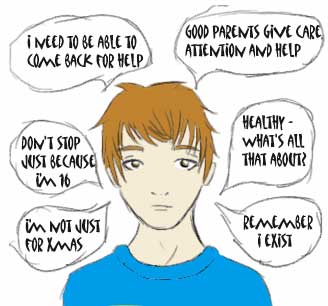These are our bairns: a guide for community planning partnerships on being a good corporate parent
Guidance for councils and their community planning partners on how to improve outcomes for looked after children and young people, and care leavers.
 06 /
COMMUNITY PLANNING PARTNERSHIPS
06 /
COMMUNITY PLANNING PARTNERSHIPS
"I have personal knowledge of how you can feel isolated, unloved, rejected and misunderstood, because you blame yourself. If you are a child you don't understand why next-door neighbours' children are living with mum and dad.
"If you've been in a care home then you can understand how your schooling is disrupted and access to medical facilities may not be routine. Children take visiting friends' homes for granted. If a Looked After child wants to play at a friend's house it's more complicated.
"Traditional provision for Looked After children was a Cinderella service. But that's all changing. At the risk of sounding like a cliché, it's a matter of joined-up working now.
"In West Lothian we have an excellent children's information sharing system called C Me. It aims to improve the way professionals work together and share information, to ensure that all children and young people get the right help from the right people at the right time.
"Just because our Looked After children have faced some very difficult family circumstances, doesn't mean that we should not have the same ambitions for them as we do for our own children.
"I want our members, who are councillors across Scotland who can make a difference, to be asking the right questions in their councils to make sure the services we provide really do fulfil our role as a corporate parent."
Cllr Isabel Hutton, West Lothian Council and COSLA Spokesperson.
It is essential that the individuals and agencies who form the corporate parent for Scotland's Looked After children and young people are more aware of and alert to their children's needs and work together to deliver for them.
"Everyone is responsible for me … provide me with the information that I ask for and listen to me a bit more. But my experience in care has allowed me to meet a lot of people who do care." (Nicole)
Councils cannot work in isolation to improve outcomes for Looked After children and young people and care leavers; the corporate parenting responsibility must be shared across the whole community planning partnership as the wider corporate family. The corporate family comprises those agencies and individuals who have a responsibility to provide services to Looked After children and young people and care leavers. Health services, independent providers, the police, the children's hearings and criminal justice systems, and further and higher education providers all play an essential part.
Community planning partnerships will be the vehicle through which the corporate family ethos is promoted and nurtured. In this context, the best interests of Looked After children and young people and care leavers should be an ever-present priority. Improving well-being, learning, inclusion, safety and opportunities within communities are high level priorities and this is especially true for Looked After children and young people, and care leavers.
As members of the wider corporate family you will want to:
- Make sure that the needs of Looked After children and young people and care leavers are articulated within the Community Plan, associated Action Plans, Integrated Children's Services Plan and Single Outcome Agreement.
- Make sure that your independent sector partners are actively engaged in the community planning partnership.
- Be confident that there is a joint focus of activity, ensuring that Looked After children and young people and care leavers are safe, healthy, active, nurtured, achieving, respected and responsible, and included.
- Be aspirational for Looked After children and young people and care leavers, holding the same expectations good parents would have for their own children.
- Make sure that all employees within your organisations are aware of their responsibilities in respect of Looked After children and young people and care leavers.
- Deliver integrated high quality services that meet the needs of Looked After children and young people and care leavers.
- Make sure that the widest range of choices and opportunities are available to Looked After children and young people and care leavers, particularly at transitional stages.
- Make sure that Looked After children and young people and care leavers are able to play a positive part in the life of their community.
- Make sure that in all that you do, Looked After children and young people and care leavers are actively involved in decisions that affect them.
- Make sure a robust approach to monitoring and evaluating the impact of activity to support Looked After children and young people and care leavers, thereby enabling you to report on and account for your progress.
HOW WILL I KNOW I'VE MADE A DIFFERENCE?
- When Looked After children and young people and care leavers are integrated into their community, whether at school or with their friends; when they participate in the local youth activities and when they feel comfortable with their own history.
- When your Looked After children and young people and care leavers achieve the same or similar goals and achievements as other children and young people.
- When Looked After children and young people and care leavers fulfil their potential, no longer feel stigmatised and excluded from services and communities.
- When all children and young people access the local services when they need them, and their experience is of the highest quality.
- When staff in different organisations know who to talk to, feel comfortable working together and sharing information and are jointly accountable for their work.
- When joint inspections demonstrate excellent collaborative integrated working.
- When there is no difference between the educational, health, employment and other life outcomes of Looked After children and young people, and care leavers, and those of their peers.
Contact
There is a problem
Thanks for your feedback